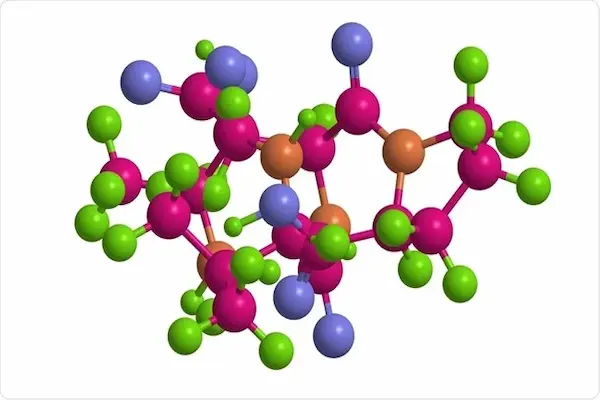
PROMO!
First order? Get 10% OFF with this code: 1storder

The Melanotan peptide is a research compound examined for how it interacts with the body’s melanocortin system, which influences skin pigmentation, energy balance, and protective responses. In lab tests, Melanotan peptide has shown potential for supporting tanning, reducing UV damage, and affecting certain metabolic pathways. Researchers have studied both Melanotan 1 (MT-1) and Melanotan 2 (MT-2), noting distinct properties and effects.
While these findings appear promising, safety for everyday use has not been proven. At Peptide Works, we supply Melanotan Peptide to researchers worldwide, ensuring reliable access for scientific studies without making any claims beyond their intended research role.
To understand why Melanotan peptide has become a focus in research, it is useful to first look at the biological system it interacts with.

The melanocortin system is made up of receptors that respond to natural signaling peptides. Among these, two receptors are most often studied with the Melanotan peptide: MC1R and MC4R.
When activated, MC1R encourages melanin production, which can lead to a stronger tanning response and added protection against UV exposure. MC4R, in contrast, is linked to appetite and energy balance, showing how this system affects more than just skin pigmentation. Researchers use the Melanotan peptide in lab tests to explore how it influences both tanning and metabolism.
With this foundation in place, it becomes easier to understand why MT-1 and MT-2, though related, are studied for different purposes.
Melanotan 1 (MT-1) and Melanotan 2 (MT-2) are both research peptides, but they act in different ways. MT-1 binds mainly to the MC1R receptor, which drives melanin production. Because of this, research often examines its role in pigmentation and UV protection, along with possible use in light-sensitive conditions.
MT-2 has a wider range, binding not only to MC1R but also to MC4R. This broader activity explains why studies explore MT-2 not only for tanning but also for effects on appetite, metabolism, and even sexual function. These differences make MT-1 and MT-2 valuable for distinct areas of peptide research.
By comparing their properties side by side, researchers can better see how each peptide serves unique study goals.
| Feature | Melanotan 1 (MT-1) | Melanotan 2 (MT-2) |
|---|---|---|
| Main receptor target | Primarily MC1R | MC1R + MC4R (broader range) |
| Research focus | Pigmentation, UV protection | Pigmentation, metabolism, sexual health |
| Duration in body | Longer half-life | Shorter half-life |
| Reported effects in studies | Steady tanning, photoprotection | Tanning, appetite changes, libido effects |
These receptor targets, MC1R and MC4R, play very different roles in the body. To see how Melanotan research connects to metabolism and skin pigmentation, it helps to examine each receptor more closely.
MC4R, or melanocortin receptor 4, plays an important part in how the body manages appetite and energy use. When this receptor is active, it can signal the brain to reduce hunger and support a better balance between food intake and calorie use. This makes it a central link between the melanocortin system and body weight control.
The Melanotan peptide, particularly MT-2, has been shown in studies to interact with MC4R. This connection helps explain why MT-2 is often explored not only for tanning but also for its influence on metabolism and appetite signals.
Having looked at metabolism, the next step is to see how MC1R differs in its role and why it remains the core focus of pigmentation studies.

MC1R, or melanocortin 1 receptor, is a key part of how the body produces melanin, the pigment that gives skin its color. When MC1R is active, it signals skin cells to make more melanin, which can darken skin tone and provide extra protection against UV rays. Variations in the MC1R gene explain why some people tan easily while others burn more quickly.
The Melanotan peptide, especially MT-1, is studied for how it interacts with MC1R to increase melanin production. This connection shows why tanning and pigmentation research continues to focus heavily on this receptor.
From pigmentation, it naturally follows to consider UV protection, since melanin also plays a defensive role for the skin.
Melanin acts as the body’s natural shield against UV rays by absorbing and scattering harmful radiation before it can damage skin cells. People with higher melanin levels often tan more easily and experience less sunburn, while those with lower levels may be more vulnerable to UV damage. This protective effect is why the role of melanin in skin safety is studied so closely.
The Melanotan peptide, particularly MT-1, is of interest because of how it can stimulate melanin production through the MC1R pathway. By boosting melanin in controlled studies, it may enhance photoprotection and reduce the impact of UV exposure, though these findings remain limited to research.
Beyond protective effects, another area of study compares how long MT-1 and MT-2 remain active in the body.

One of the key differences between Melanotan 1 (MT-1) and Melanotan 2 (MT-2) is how long they remain active after use in lab studies. MT-1 has a longer half-life, meaning its effects on pigmentation and UV protection can be sustained for a greater period of time. This makes it the peptide more often linked to steady tanning outcomes in controlled research.
MT-2, by contrast, has a shorter half-life and is cleared from the body more quickly. While its effects may appear faster, they do not last as long. These differences in duration are why MT-1 and MT-2 are often studied for slightly different purposes within the broader field of Melanotan research.
Taken together, these insights highlight the growing importance of Melanotan peptides in ongoing peptide studies.
Melanotan peptides are of growing interest in studies of tanning, UV protection, and metabolism. MT-1 is noted for its steady pigmentation and longer-lasting effects, while MT-2 is explored for its quicker action and broader impact on appetite and energy balance. These differences make both peptides important for understanding the melanocortin system and its role in the body.
At Peptide Works, we provide researchers worldwide with trusted access to Melanotan peptides. Our commitment is to offer consistent quality and reliable service, making it easier for professionals to source the compounds they need with confidence.
These peptides are for research purposes only and are not for human use.
[1] Dorr RT, Ertl G, Levine N, Brooks C, et al. Effects of a superpotent melanotropic peptide in combination with solar UV radiation on tanning of the skin in human volunteers. Arch Dermatol. 2004 Jul;140(7):827-35.
[2] Ugwu SO, Blanchard J, Dorr RT, Levine N,et al. Skin pigmentation and pharmacokinetics of melanotan-I in humans. Biopharm Drug Dispos. 1997 Apr;18(3):259-69.
[3] Côté I, Sakarya Y, Kirichenko N, Morgan D, et al. Activation of the central melanocortin system chronically reduces body mass without the necessity of long-term caloric restriction. Can J Physiol Pharmacol. 2017 Feb;95(2):206-214.
[4] Mun Y, Kim W, Shin D. Melanocortin 1 Receptor (MC1R): Pharmacological and Therapeutic Aspects. Int J Mol Sci. 2023 Jul 29;24(15):12152.
[5] Wessells H, Levine N, Hadley ME, Dorr R, Hruby V. Melanocortin receptor agonists, penile erection, and sexual motivation: human studies with Melanotan II. Int J Impot Res. 2000 Oct;12 Suppl 4:S74-9.
ALL CONTENT AND PRODUCT INFORMATION AVAILABLE ON THIS WEBSITE IS FOR EDUCATIONAL PURPOSES ONLY.
DISCLAIMER: These products are intended solely as a research chemical only. This classification allows for their use only for research development and laboratory studies. The information available on our Peptide Works website: https://peptide-works.com/ is provided for educational purposes only. These products are not for human or animal use or consumption in any manner. Handling of these products should be limited to suitably qualified professionals. They are not to be classified as a drug, food, cosmetic, or medicinal product and must not be mislabelled or used as such.
Peptide Works
Related Articles

Could Orexin A peptide Treat Daytime Fatigue?
Waking up tired frustrates many people. Dragging through a full day with heavy eyes and slow focus makes work and

How can the Adamax Peptide help Chronic Inflammation?
Chronic inflammation acts like a fire that never stops burning. It slows recovery, drains energy, and blocks proper tissue repair.

Can Vitamin B12 Immune System Support Enhance the Effects of Thymosin Alpha-1?
The Vitamin B12 immune system link is important because this vitamin plays a crucial role in DNA synthesis, methylation, energy